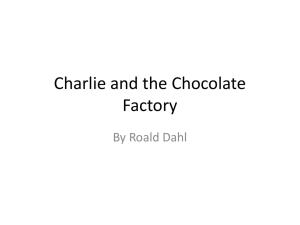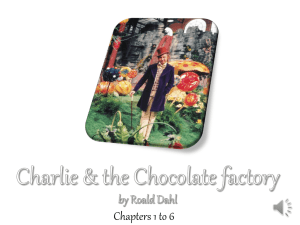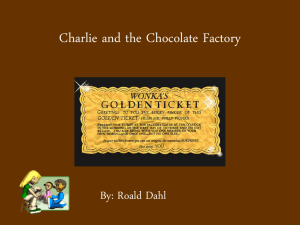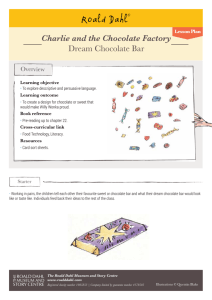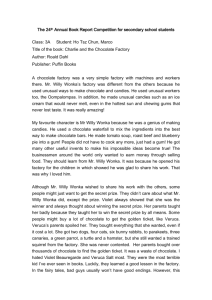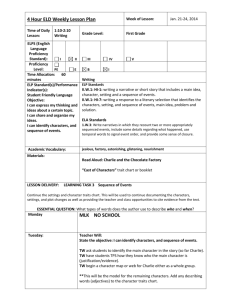Charlie and the Chocolate Factory
advertisement
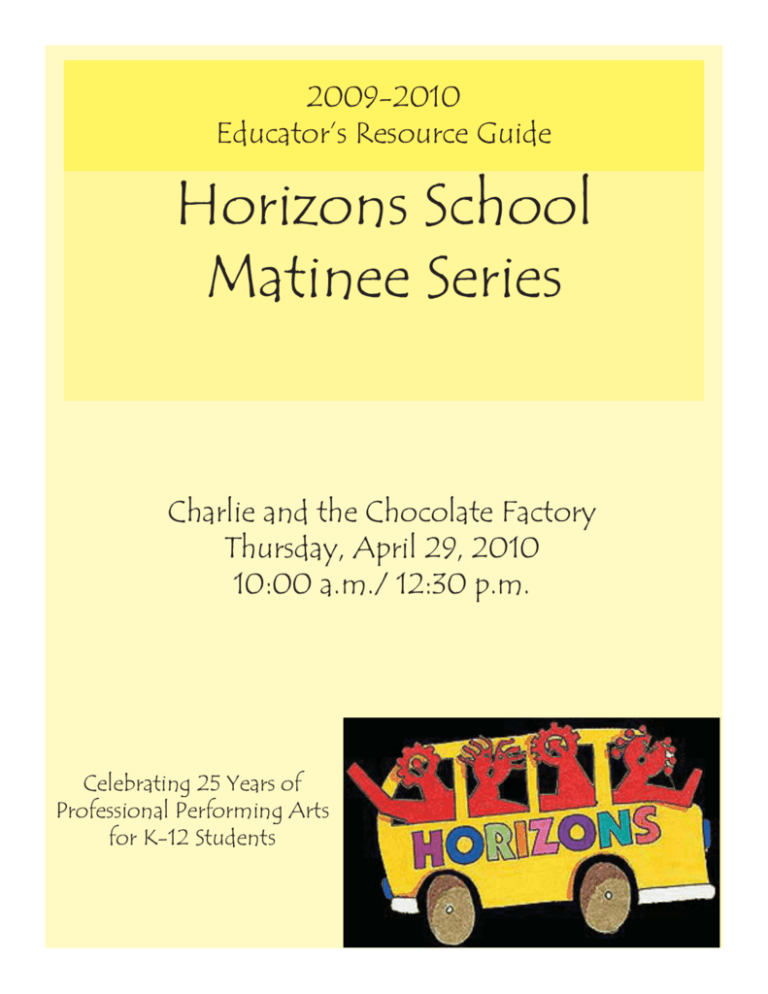
2009-2010 Educator’s Resource Guide Horizons School Matinee Series Charlie and the Chocolate Factory Thursday, April 29, 2010 10:00 a.m./ 12:30 p.m. Celebrating 25 Years of Professional Performing Arts for K-12 Students Horizons School Matinee Series Thank you for joining us as we celebrate the 25th anniversary season of the Horizons School Matinee Series. We are proud to announce that over half a million students have experienced a professional performing arts event with us since the inception of this program. This season continues the tradition of providing great performances to enhance learning, fire imaginations, and reinforce school curriculum in meaningful ways. Thank you for expanding children’s minds and sharing with them the joy of the performing arts! This resource guide has been designed to help you prepare your students with before activities that help them engage in the performance and after activities that encourage them to evaluate the performance and make relevant personal and academic connections. Within the guide you will find a variety of activities that can be used to enhance the core subject areas as well as the creative arts. Wisconsin Academic Standards are listed at the end of the guide to help you link the activities to your lesson plans. The materials in this guide reflect the grade range recommended by the performing arts group. As teachers, you know best what the needs and abilities of your students are; therefore, please select and/or adapt any of the material to best meet the needs of your particular group of students. Thank you for your support! Shannon Dozoryst Education and Outreach Coordinator Horizons Educator’s Resource Guide: Charlie and the Chocolate Factory Credits ABOUT YOUNG AUDITORIUM AT UW-WHITEWATER Editor: Shannon Dozoryst The Young Auditorium is located on the University of WisconsinWhitewater campus and serves both the campus and public communities. The auditorium presents the highest quality arts and entertainment Charlie and the Chocolate programming in a wide variety of disciplines for diverse audiences. There Factory Study Guide is something for everyone each season at Young Auditorium, including provided by SignStage touring Broadway shows; classical, jazz, rock, pop, and folk music; family Theatre entertainment; school matinee performances; world-class ballet and opera; comedy; and lectures. This season marks the Young Auditorium’s 15th year of sensational performing arts programs under the big, blue roof. The ground breaking for the auditorium in June 1991 was made possible through the Irvin L. Young Foundation. The Foundation, along with the auditorium, honors an individual whose name had long been associated with philanthropy and humanitarianism throughout the state of Wisconsin and around the world. From humble beginnings, without the advantages of a high school or college education, Mr. Irvin Young used his time, talents and strong entrepreneurial spirit to establish a variety of successful businesses. Inspired by a business trip to Africa and the commitments he formed there, Mr. Young established the Irvin L. Young Foundation in 1949. Mrs. Fern Young continued her husband’s benevolence until her death in January 2002. Thousands of people, both at home and abroad, have been positively affected by their kindness. It is our goal that, by bearing Mr. Young’s name, we continue in his path of serving Wisconsin residents for years to come. Teachers have permission to reproduce any and all parts of this study guide for classroom use only. HORIZONS SCHOOL MATINEE SERIES The mission of the Horizons program is to support the curriculum of schools by providing culturally diverse programs and outreach opportunities for K-12 students. This will be accomplished through 1) providing performances and hands-on, interactive outreach opportunities that cultivate an appreciation for the performing arts among young people that will last throughout their lives and 2) supporting teachers through professional development opportunities in the arts. It is our vision that someday every K-12 student in the auditorium’s service region will attend a Horizon’s performance and/or participate in an outreach event each year. Sign Stage on Tour Teacher’s Guide Charlie and the Chocolate Factory by Roald Dahl Published by Penguin, 1964 Story Outline Meet Charlie Bucket, our hero. He's a poor boy from a poor extended family where everyone lives in a small house with only one room. For the most part, Charlie and his mother are the only people earning money for the family. Charlie has a paper route, and his mom works in a laundromat. We get a feeling early on that of all his bed-stricken family, Charlie likes his Grandpa Joe the best. could wait. But, now that she has the Golden Ticket, she is back on her gum. Charlie does his best to keep his family comfortable. He puts every cent he earns into food for his relatives. Although, like many children his age, he would like to spend his money on things like candy and other treats. Charlie dreams for better things for his family and when the mysterious Wonka Chocolate Factory starts a contest where the grand prizewinner gets a lifetime supply of chocolate, Charlie sees his chance to break his family out of poverty. We soon find out a man in Paraguay has found the last Golden Ticket. The contest is over and Charlie is devastated. Here's how the contest works. There are five golden tickets hidden in bars of Wonka Chocolate. These chocolate bars are shipped all around the world. Whoever finds the golden ticket is entitled to a tour of the factory that no one has ever seen the inside of. And, as if that were not enough, they get a lifetime supply of chocolate. Each prizewinner is allowed to bring a guest to the factory as well. The Wonka contest has turned the world upside-down. Candy stores are turned into war zones. Shopkeepers cannot keep the candy on the shelves. People are crazed to try to find the golden tickets. It doesn't take long for the first Golden ticket to turn up. A boy named Augustus Gloop is the lucky finder. Augustus is a big boy. When he is asked how he feels about finding the ticket he replies, "I feel sorry for Wonka. It's going to cost him a fortune in fudge." For Charlie's birthday the whole family makes him a scarf. His two Grandfathers pitch in to get him a Wonka bar. Charlie eagerly opens the wrapping but only finds chocolate. We are then introduced to Veruca Salt, the very demanding daughter of a successful businessman. Mr. Salt has stopped the regular work at his factory so his workers could open case after case of Wonka bars. Veruca is not pleased that she hasn't been given the Golden Ticket her father promised her. Finally, one of the workers finds Golden Ticket number two and is escorted through the factory to put the Golden Ticket in the waiting hands of the impatient little Veruca. All over the world stores are sold out. Shipments are being moved in armored cars with armed guards. People go to extreme lengths to get the Golden Tickets. Newly developed computers have even been used to try to locate the Golden Tickets. Ticket number three is soon discovered in the USA. Violet Beaureguard, the daughter of a used car salesman and avid gum chewer, heard about the contest and decided her gum chewing Mike Teevee discovers golden Ticket number four, but the news interviewers can’t get his attention away from the television set. His mother explains that all he does is watch television. Westerns interest him the most. The next day on his way home from school Charlie finds some money in the street. He decides to reward himself by feeding his sweet tooth. He buys the biggest bar of chocolate he can find, and eats it right away. As he is leaving, he decides to get Grandpa Joe a Wonka bar with the rest of the money. As he gets to his paper stand to get the papers for his delivery route he finds it surrounded by a swarm of people all very eager to get a paper. As it turns out, the Golden Ticket found in Paraguay was a fake and there was, in fact, one more Golden Ticket out there somewhere. Charlie walks away from the crowd and gets out the Wonka bar he bought for Grandpa Joe. He slowly opens it and to his shock as well as the people around him, he has found the fifth Golden Ticket! Charlie runs straight home but on his way there a mysterious man, who was around all the other Golden Ticket winners, stops him. He introduces himself as Mr. Slugworth, President of Slugworth Chocolates. He offers Charlie a great sum of money if Charlie would just bring him a new invention from the Wonka Factory, an "Everlasting Gobstopper". Charlie runs home ever faster, and bursts through he door shouting that he has the fifth Golden Ticket. The family didn't know about the fake Golden Ticket in Paraguay so they don't believe Charlie at first. They change their minds when Grandpa Joe reads the Golden Ticket. Charlie desperately wants Grandpa Joe to go to the factory with him. Grandpa Joe slowly gets out of bed and discovers he can still walk. They dance around the small house and celebrate their good fortune and prepare for the factory tour the next day. Five lucky children have won the chance of a lifetime to tour Mr. Willy Wonka’s chocolate factory. They will have the opportunity to explore all the machinery and inner workings of the mysterious factory where the world’s most wonderful candy is made. The children, including Charlie, arrive at the factory and proceed through the front gates. Each is eager to claim the prize. But, one by one, these greedy children pay a price for their shortsightedness, until only Charlie is left. What does the eccentric Willy Wonka want? Who are the unknown factory workers who throw very tiny shadows on the windows and talk in rhyme? As Charlie tries to solve these puzzles, he learns about himself and a simple lesson. Join Charlie on his wild adventure and meet the cast of zany characters in this adaptation of Charlie and the Chocolate Factory by the world-renowned author, Roald Dahl. Roald Dahl His life - a short description Roald Dahl described his life in two books, "Boy" and "Going Solo". The first volume deals with his childhood, the second one with his life after school. His parents were from Norway, but he was born in Wales, 1916. The family used to spend the summer holidays on a little Norwegian island, swimming, fishing and boating. When Roald was four years old, his father died, so his mother had to organize the trip alone for herself and her six children. After graduating from Repton Preparatory School in 1933, Roald Dahl didn't go to college but applied for a job with the Shell Oil Company because he was sure they would send him abroad. He was sent to East Africa where he got the adventure he wanted: great heat, crocodiles, snakes and safaris. He lived in the jungle, learned to speak Swahili and suffered from malaria. When the second World War broke out, he went to Nairobi to join the Royal Air Force. He was a fighter pilot and shot down many planes. He himself was shot down. After 6 months in a hospital, he resumed active duty and flew again. Roald’s life as a writer began almost by accident. C. S. Forester came to ask if he could interview him for a piece he was writing for The Saturday Evening Post because Roald had “seen action” in World War II. Forester tool Dahl to lunch with the intentions of taking notes about his most exciting war experiences. However, Forester was having difficulty taking notes while eating, so Dahl offered to write down some notes and send them to him. The notes ended up being a story, which he called “A Piece of Cake.” Forester sent the story to The Saturday Evening Post under Dahl’s name. The Post liked the story so much they paid Dahl $1,000 and then signed him to write others. Soon his stories were being published in several other magazines, and his writing career had started. In 1942, he went to Washington DC as an Assistant Air Attaché. There he started writing short stories. In 1943, he published his first children’s book, "The Gremlins." Eleanor Roosevelt read it to her grandchildren and like it so much that she invited him to have dinner with her and the President at the White House. They had such a good time, he was invited again, and then the visits extended to weekends at their country house. His collections of short stories have been translated into many languages and have been best sellers all over the world. Among them are "Someone Like You," "Sweet Mystery Of Life," "Kiss Kiss" and "Roald Dahl's book of Ghost Stories." He wrote a TV series, "Tales of the Unexpected," and the novel "My Uncle Oswald". His books are mostly fantasy and full of imagination. They are always a little cruel but never without humor - a thrilling mixture of the grotesque and comic. A frequent motif is people are not what they appear to be. Mary Maloney in "Lamb to the Slaughter," for example, is not a friendly widow but a clever murderess. In his stories, the background is perfectly worked out: details are very close to reality. His stories have unexpected endings and strange, menacing atmospheres. Roald Dahl didn't only write books for grown-ups but also for children, such as "James and the Giant Peach," "Fantastic Mr. Fox" and "The Gremlins." About his children's stories he once said, "I make my points by exaggerating wildly. That's the only way to get through to children." Roald Dahl is an extremely popular and best-selling children's book author. However, these stories are so sarcastic and humorous, adults also appreciate reading them. In 1971, the movie Willy Wonka and the Chocolate Factory, starring Gene Wilder as Willy Wonka, was produced from the book Charlie and the Chocolate Factory. The movie’s screenplay, written by Roald, is visually stunning and cleverly written. The songs are remarkable. The scenery and props are “candy for the eyes.” The whole movie is a fun journey through the chocolate factory. It’s a very enjoyable, fun and clever movie that should be viewed by everyone. Roald Dahl died in November, 1990. The New York Times called him "one of the most widely read and influential writers of our generation." He wrote two autobiographies, seventeen children’s books, two novels, three poetry books, twenty-six short stories, eight screenplays and six miscellaneous books. He had quite a distinguished career for a person who started out having no thoughts of being a writer or author. Reading/Writing Connections 1. Have students preview the book by looking at the title, author description, cover illustrations, and chapter titles to make predictions about the story. 2. Have students answer an anticipation guide based upon issues brought up in the book (i.e. - poverty, greed, pleasures, television viewing, parents, fantasy, chocolate, grandparents, contests, gifts). 3. Have students write to different chocolate companies to find information on their products. 4. Discuss character development and have students compare/contrast the main characters. Ask them to pick a character from a story that they are writing and add rich detail as Dahl has done. Vocabulary/Spelling: 5 absurd envious wretched belching beckoned frump pandemonium colossal morsels despair dotty despicable balmy ravenously ferociously astonish rubbish intently abide hooligan Communication Arts Connection 1. Have readers' theatre on selected chapters from the story. 2. Have students interview each other pretending to be one of the five children after they found out they were the winners. 3. After reading the book, watch the film Willy Wonka and the Chocolate Factory. Have students compare/contrast the book to the movie. 4. Have students invent a new candy bar in small groups. Then they are to design a wrapper, slogan and advertisement to share with the class. Library Connection 1. Introduce students to other books written by Roald Dahl. Have them select a book they have not previously read and form literature circles to read and discuss their books. 2. Have students select a topic discussed in the book and have them research their ideas in small groups. Discuss different ways students can conduct their research such as information from books, encyclopedias, the internet, etc. (Possible topics - nutrition, candy, Roald Dahl, television, squirrels, inventions, fantasy stories, behavior, factories, etc.) 3. Share Boy, an autobiography written by Roald Dahl. Work with Media Specialist to introduce students to autobiographies and biographies. Have students select a person they would like to find more about and read their autobiography or biography. Students should do some type of report on their subject. Social Studies Connection 1. Read multicultural myths and legends, which explain how things came to be. Then research the history of chocolate. Have students work in small groups to write a legend based upon chocolate and share with the class. 2. Locate materials about the growing of cocoa. Have the students research details about the major cocoa producing countries. Have them create maps, charts, and graphs to show: the type of climate, soil, rainfall, amount of land used for growing this product, revenue gained from the product, and diversification of chocolate products. 3. Have students interview a parent or grandparent about their family and complete a family tree. 4. Ask students to bring in family recipes using chocolate from their culture and assemble a class cookbook. Science Connections 1. Conduct a taste test using different brands of chocolate bars. Take the students through the scientific process by asking which is the most popular chocolate bar in our class. 2. Have students tune their observation and note taking skills by logging in a science journal every time they eat junk food. Have them include food, time, place, and feelings to become better aware of their behaviors. 3. Study the food pyramid and the basic food groups. Construct models of good eating habits using all food groups. Art/Music Connection 1. Sing the songs that the Oompa - Loompas sang at the end of some chapters. Have students make up songs for the remaining characters or for themselves. 2. Illustrate descriptive scenes from the book, such as the inventing room, based upon Dahl's rich description. 3. Draw the design of a new machine that Mr. Wonka could use in his factory. Math Connections 1. Do M&M math. Some activities include sorting, counting, adding, subtracting, multiplying, dividing, graphing and fractions. 2. Measure different candy bars in small groups. Determine the length, width, height, area, perimeter and volume. 3. Make a graph based upon students' favorite candy bars. 4. Weigh each candy bar and round each weight to the nearest ounce. List the candy bars in order from lightest to heaviest. 5. If you used Willy Wonka's Chocolate Television, everything would shrink. If they shrunk to 1/6 their original size, what would be the new measurements for the items you just measured? 4. Design a Golden Ticket similar to the ones Willy Wonka placed inside the candy bars. What would the ticket say? Make up your own words. 5. Build a model of the boat the Oompa - Loompas paddled down the chocolate river. Salt dough can be used as a modeling agent. Salt dough is made by mixing 3 cups of plain flour and 1 cup of salt with approximately 3/4 cups of warm water. Food coloring or acrylic paint may be added to the warm water before mixing. 6. Create stick puppets for each of the main characters in the book. These can be made from salt dough, felt, foam, craft sticks, and moveable eyes. Have the students guess which one is which character. Baking Activity Here's a recipe you can use to make about 5 dozen chocolate balls with your class: What you need: 3 cups of semi-sweet or white chocolate chips or white chocolate chips 1 can of sweetened condensed milk finely chopped nuts (your choice) cocoa powder What to do: 1. 2. 3. 4. Melt chocolate chips; remove from heat. Stir in sweetened condensed milk. Chill 3 hours or until firm. Shape into 1 - inch balls; place on wax paper-lined trays. Chill until firm. Roll in chopped nuts, cocoa, or dip into melted chocolate chips of a different color. 5. Chill and enjoy. Popular Direct Hit Web Sites 1. Wonka - Enter the Gates to the Wild World of Wonka! Welcome, my friends to the Wild World of Wonka. Come with us for a wild ride through the official Web site of the Willy Wonka Candy Factory. Inside you'll find sweet treats like games, trivia, and other free goodies. www.wonka.com 2. Charlie and the Chocolate Factory/Dahl, Roald; Charlie and the Chocolate Factory, "Greetings to you, the lucky finder of this Golden Ticket, from Mr. Willy Wonka! I shake you warmly by the hand! Tremendous things are in store for you!" The Golden Ticket allows Charlie to fulfill his dearest wish. www.bookworm.com 3. E! on line - Movie Facts - Willy Wonka and the Chocolate Factory (1971) Willy Wonka and the Chocolate Factory celebs, reviews, gossip, features, news, home search, are featured here. TV multimedia fun & games. www.eonline.com 4. A Guide for Using Charlie & the Chocolate Factory in the Classroom Paperback - 48 pages (January 1, 1993) www.iewww.com/content/1557344205 5. Roald Dahl This official site includes illustrations from Quentin Blake, plus treats for kids, tips for teachers, and details of the Roald Dahl Foundation. www.roalddahl.com 6. Roald Dahl Fans Included are resources for students, teachers, and fans including biographical information, book and movie details, lesson plans, and homework help. www.roalddahlfans.com 7. The Roald Dahl Club www.roalddahlclub.com Reflecting on the Performance Write a friendly letter - As a way to reflect on the play, ask your students to write the Young Auditorium staff a letter. Our staff would love to hear what your students think about the Horizons productions they experience. For your convenience there is a letter template on the next page that is ready for you to reproduce for your students. This activity will provide your students with the opportunity to practice their writing skills by writing a critical evaluation of the Horizons performance for an authentic audience. Write a Review - Create an idea map on the board by asking students to brainstorm everything they remember from the performance. The first part of this activity should be objective; remind students that they will be able to express their opinions when the write the review. Prompt students with the following questions: Was there music involved? If so, what kinds of songs did they sing? In what different ways did the actors use their voices? What costumes did the actors wear? How did the different characters move? What did the set on the stage look like? What else can you remember? - Instruct students to write a review that includes the following components: 1) A rating, out of five stars 2) One paragraph that objectively describes what you saw and heard at the performance 3) For each star in your rating, explain one thing you liked about the performance (e.g. a four star rating equals four things you liked about the show) 4) For each star under five, explain one thing you didn’t like about the performance (e.g. a three star rating equal two things you didn’t like about the show) 5) Use at least two of the new vocabulary words from this study guide in your review 6) Use the stages of the writing process to produce your review: pre-writing, draft, review, revise, edit 7) Publish your work by sending it to Young Auditorium! (Use the address on the letter tem plate on the next page.) We would love to hear from you, and our education coordinator will write back! Create a Theatre Journal - Download and reproduce the four Theatre Journal pages available on the Young Auditorium web site. www.uww.edu/youngauditorium/HorizonsSeries.php Copy the pages back-to-back and fold them down the middle into a booklet. There are a variety of writing and drawing activities to stimulate your students’ imaginations before and after the play. Horizons Educator’s Resource Guide: Charlie and the Chocolate Factory Young Auditorium Horizons School Matinee Series 930 W. Main Street Whitewater, WI 53190 Dear Horizons: My name is __________________________________________ I attend __________________________ School in _______________________ (city or town). I just saw ______________________________________________________ (name of show). I liked the performance because My favorite part was when One question that I have is Signed ________________________________ Wisconsin Academic Standards Language Arts A.4.2 Read, interpret, and critically analyze literature. (Activity: Read and discuss Charlie and the Chocolate Factory by Roald Dahl.) A.4.3 Read and discuss literary and nonliterary texts in order to understand human experience. (Activities: Read Story Outline and Roald Dahl Biography; Library Connection) B.4.1 Create or produce writing to communicate with different audiences for a variety of purposes. (Activities: Reflecting on the Performance) C.4.1 Orally communicate information, opinions and idea effectively to different audiences for a variety of purposes. (Activities: Communication Arts Connection) C.4.2 Listen to and comprehend oral communications. (Activities: Communication Arts Connection) C.4.3 Participate effectively in discussion. (Activities: Reading/Writing Connections) D.4.1 Develop their vocabulary of words, phrases, and idioms to improve communication. (Activities: Vocabulary/Spelling: 5) Social Studies E.4.3 Describe how families are alike and different, comparing characteristics such as size, hobbies, celebrations, where families live, and how they make a living. (Activities: Social Studies Connection) E.4.4 Describe the ways in which ethnic cultures influence the daily lives of people. (Activities: Social Studies Connection) Science B.4.1 Use encyclopedias, source books, texts, computers, teachers, parents, other adults, journals, popular press, and various other sources, to help answer science-related questions and plan investigations. (Activities: Science Connections) C.4.2 Use the science content being learned to ask questions, plan investigations, make observations, make predictions, and offer explanations. (Activities: Science Connections) Math B.4.2 Determine the number of things in a set by grouping and counting (e.g., by threes, fives, hundreds); combining and arranging (e.g., all possible coin combinations amounting to thirty cents); estimation, including rounding. (Activities: Math Connections) D.4.4 Determine measurements directly* by using standard tools to these suggested degrees of accuracy. (Activities: Math Connections) Art/Music C.4.6 Use sketching to develop ideas for their artwork. (Activities: Art/Music Connection) C.4.7 Develop basic skills to produce quality art. (Activities: Art/Music Connection) E.4.4 Communicate basic ideas by producing visual communication forms useful in everyday life, such as sketches, diagrams, graphs, plans, and models. (Activities: Art/Music Connection) Theatre Education A.4.1 Attend a live theatrical performance and be able to analyze, evaluate, and create personal meaning from the experience through small group discussion. (Activities: Attend the performance Charlie and the Chocolate Factory and discuss as a class.) Horizons Educator’s Resource Guide: Charlie and the Chocolate Factory Theatre Vocabulary A-Z Act: 1. To perform a role on stage; 2. One of the main divisions of a play or opera, i.e. Act I, Act II Actor: Someone who performs a role on stage Applause: To show approval by clapping the hands Apron: The part of the stage that extends in front of the main curtain Audience: Spectators that listen to or watch a performance Backstage: The part of the stage and theater that is out of sight to the audience Balcony: A platform inside of a building extending out over part of the main floor, as in a theatre Blackout: A fast shutdown of lights to darkness Bow: To bend the head, body or knee in acknowledgement Box Office: Refers to the ticket office where people can buy tickets for a show Cast: The group of actors or performers in a show Catwalk: A walkway above the stage used to gain access to equipment Choreographer: A person who arranges dances or other movements Company: The cast, crew, and other staff associated with a show Costumes: Clothes worn by the actors on stage Crew: People that perform the technical tasks for a show Cue: The signal for an actor or crew member to do an action Curtain Call: At the end of a performance, the acknowledgement of applause by actors taking bows Dialogue: The spoke text of a play, conversations between characters Director: Person who guides the making of a show Downstage: The part of the stage nearest to the audience Dress Rehearsals: A full rehearsal in costume, to practice the show as it will be on show night Horizons Educator’s Resource Guide: Charlie and the Chocolate Factory Dressing Rooms: Room in which actors change into their costumes and apply make-up Equity: Short for American Actor’s Equity Association, the trade union of actors, directors, designers and stage managers (www.actorsequity.org) Follow Spot: A hand operated lighting instrument that emits a high intensity beam of light used to follow an actor on stage Front of House: Areas of the theatre in front of the proscenium arch, includes lobby areas open to the general public Gel: Thin, transparent sheet of colored plastic used to color stage lights Ghost Light: A light on a pole that is left on stage when nobody is there so the last person out and the first person in won’t fall off the end of the stage in the dark Green Room: Room close to the stage for the actors to meet and relax House: 1. The audience inside the theatre; 2. The seating area inside the theatre Intermission: A brief break between acts of a performance, usually ten to twenty minutes long Load In/ Load Out: Process of moving a production in or out of the theatre Matinee: A performance held in the daytime, especially in the afternoon Musical: A play whose action and dialogue is interspersed with singing and dancing Orchestra Pit: Sunken area immediately in front of the stage, intended to accommodate an orchestra Props: Something other than scenery or costumes that is used in a performance, short for “properties” Proscenium: The frame separating the stage from the audience Rehearsal: A practice session in preparation for a public performance Script: The text or a musical or play Set: The complete stage setting for a scene or act Sound Check: A thorough test of the sound system before a performance Horizons Educator’s Resource Guide: Charlie and the Chocolate Factory Stage: the part of the theatre on which performances take place Stage Manager: A person who is in charge of the stage and the related details of a performance Stage Right/ Stage Left: The left and right of the stage from the point of view of the actor on stage looking at the audience Theatre: A building or area for dramatic performances Understudy: Someone who studies another actor’s part in order to be his or her substitute in an emergency Upstage: The part of the stage furthest from the audience Usher: A person who guides audience members to their seats Wardrobe: The general name for the costume department Wings: The out of view area to the left and right sides of the stage A Lesson in Theatre Etiquette A fun way to review theatre etiquette with your students is to have them compare appropriate dress and behavior for the theatre with other activities such as attending a concert, going to a movie, swimming at the beach, going to a sports game, or going to the mall with family or friends. Divide the class into groups and assign each group a different activity. Have the groups list the appropriate dress and behavior for their activity and why. The groups can then briefly role play their activity and present their ideas to the rest of the class. After all groups have presented, discuss how we behave differently for a live theater performance than we do for other activities (such as watching TV or a movie). Print copies and review the “Courtesy Counts” sheet in this guide with your students. Horizons Educator’s Resource Guide: Charlie and the Chocolate Factory Courtesy Counts Please share this information with your students . . . most children are unfamiliar with proper theatre behavior. Make sure you share these courtesies as a part of their experience, and be sure to select shows appropriate for their age & attention span. Have them use the restroom before the performance begins. Produce positive energy…Watching a live theatre performance is very different from watching a movie or television show. A live presentation has not been prerecorded with the mistakes edited out. The audience’s behavior and reactions can either add or detract from a performance. Each audience member affects those around him/her as well as the performers. Concentrate on helping the performers by producing only positive energy! Find your seat…An usher will show you where to sit. Walk slowly and talk quietly as you are seated. Keep it clean…Gum, food, and beverages are not allowed in the theatre! Quiet on the set . . . Young Auditorium is known for its excellent acoustics, so if you make a noise others will hear you (including the performers)! Please no talking, humming, unwrapping cough drops, candy, or foot tapping during the performance. Exceptions to this rule include shows that ask for audience participation. Applause and laughter are appreciated and appropriate. Unplug . . . Turn off pagers, cell phones, cameras, and watch alarms during performances. Better yet, leave them at home or school! Only use your memory as a recording device . . . Flash photography and video recording is not allowed during performances because the bursts of light are dangerous to the performers on stage and distracting to other patrons. Please keep recording equipment at home or school or conceal it in a jacket pocket or purse. Respect personal space . . . Please keep feet on the floor, not on the seat or balcony in front of you. Shifting in your seat, wearing hats, or wandering in the aisles is extremely distracting to those around you; please stay in your seat until intermission or the final curtain. Horizons Educator’s Resource Guide: Charlie and the Chocolate Factory FOR YOUR INFORMATION (teachers & chaperones) PLACE: All Horizons School Matinee Series performances will be held in Young Auditorium, on the UW-W campus. Musical Encounters concerts are held in the Light Recital Hall in the Greenhill Center of the Arts. You will be escorted from the auditorium to the recital hall if you are attending a concert. TIME: The doors of the auditorium will be opened 30 minutes prior to curtain time. Please arrange your schedule so the buses will arrive with time for seating and a bathroom stop. Late arrivals will not be seated until there is an appropriate pause in the production. BUSES: The east side of Lot 1 is reserved for buses that are staying for the duration of the Horizon’s performance. Buses that are not staying will pull into Lot 2 and line up along the curb to drop off and pick up students. Please make sure that your bus driver receives the Bus Driver’s Memo available on our website. WHEELCHAIR: All entrances are wheelchair accessible. If you have upper level seats, use the elevator. Main floor seats are on the same level as the lobby. Please inform us at least 4 weeks in advance if you need wheelchair seating or any other special accommodations. RESTROOM: Main floor men’s and women’s restrooms are located on each side of the auditorium. On the upper level, the women’s restroom is on the south side and the men’s restroom is on the north side of the building. Please try to limit your restroom visits to before or after the show. SEATING: An auditorium escort has been assigned to your school. The escort will direct you to your seats. All seats are reserved; thus each group must adhere to the seating assignment and may use only the number of seats reserved. Please plan to have chaperones seated with the students under their supervision. Chaperones - please do not bring infants/babies to the school matinee performance. After all the students and respective chaperones have been seated, please settle in and remain seated during the entire show. No one should leave the hall until after the final curtain, except in the case of emergency. Leaving during the performance is exceedingly distracting for both the performers and members of the audience. If students must leave during the performance for any reason, re-entry into the auditorium will be allowed only when there is an appropriate pause in the program. CAMERAS/ RECORDERS AND CELL PHONES: The use of cameras or recorders during any performance is strictly forbidden. Please do not bring them to the program. Cell phones must be turned off for the duration of the program. We encourage you to ask your students not to bring cell phones with them to the theatre. Horizons Educator’s Resource Guide: Charlie and the Chocolate Factory FOOD, drinks, and chewing gum are not permitted in the auditorium. EMERGENCY: Please contact the nearest usher in case of emergency. LOST ARTICLES: Report lost articles to the house manager, or call 262-472-4444. EXITING: Please disperse in an orderly manner. Teachers and chaperones have the responsibility of keeping their group together. Ushers are not assigned to oversee your exit from the building. BUS PICK-UP: Your bus pick-up will be the same place as the drop-off. LUNCH: Local fast food establishments and restaurants, as well as UW-W campus dining (262-472-1161) are happy to accommodate your group for lunch. Please make advanced arrangements to promote efficient service. LUNCH SPACE: Schools may request a place to eat their bag lunches. Young Auditorium can accommodate a very limited number of people eating lunch picnic-style seated on the floor. This must be scheduled in advance. You will receive an admission slip in the mail confirming lunch space, which you must bring along with your lunches. We thank you, in advance, for cooperating in implementing these procedures, giving all audience members the opportunity to sit back, relax, and enjoy the show. Thank you for coming – we appreciate having you as a part of the Horizons program! SPECIAL NOTE: Please print the Bus Driver Memo/ Map from our website and give it to your driver on the day of the show! Policies Please note the following policies are in place to ensure enjoyment for all! The house opens at least one-half hour before the curtain. A seat must be purchased for everyone attending an event, including teachers, chaperones, and bus drivers. Timing is everything . . . so don’t be late! Performances begin at 10:00 a.m. and 12:30 p.m. so plan to arrive at the theater 30 minutes early. Patrons arriving late are seated only when there is a suitable pause in the performance. Horizons Educator’s Resource Guide: Charlie and the Chocolate Factory UW-Whitewater/ Young Auditorium 930 W. Main Street Whitewater, WI 53190 262-472-4444 (main office) 262-472-4400 (fax) www.uww.edu/youngauditorium Shannon Dozoryst Education and Outreach Coordinator 262-472-1432 (office) 262-472-4400 (fax) dozoryss@uww.edu www.uww.edu/youngauditorium/horizonsSeries.php Staff: Ken Kohberger, Director Shannon Dozoryst, Education and Outreach Coordinator Malinda Hunter, Office Manager Leslie LaMuro, Marketing Director Michael Morrissey, Audience Services Coordinator David Nees, Technical Director Ben Strand, Development Director The Horizons School Matinee Series is funded cooperatively by the University of Wisconsin-Whitewater, participating schools, grants from the Wisconsin Arts Board, Dorothy Remp Elmer Children’s Arts Outreach Endowment, and Target, and a partnership with the National Endowment for the Arts, in addition to various public and private institutions. Young Auditorium is a non-profit organization under Section 115 of the Internal Revenue Code. The Dorothy Remp Elmer Children’s Arts Outreach Endowment
